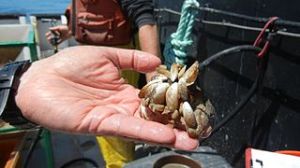“I came, I saw, I conquered!” say invasive species in the Great Lakes:
Many of the most abundant species in Lake Ontario are non-native.
According to Brian Weidel of the U.S. Geological Survey, “My colleagues and I often joke if we only studied species that were native, most of us in Lake Ontario would be out of a job.”
He says species such as quagga mussels and round gobies can push out native species. But once they’re entrenched it’s hard to remove them and they become a part of the food web.
For example, invasive gobies are a now a source of food for many sport fish. So while the ecosystem has changed because of invasives, Weidel adds:
“It still provides clean water to drink, great recreation opportunities, lots of fish to eat. It’s still a natural ecosystem.”
Get Schooled:
- Learn more about invasive species from New York Sea Grant.
- Check out Ontario’s Invasive Species Awareness Program.
Hear More:
Brian Weidel discusses why the Great Lakes eco-system is so susceptible to invasive species:
Watch more:
Watch a segment on one of the invasive species in the Great Lakes, Asian carp (via Shedd Aquarium):
The fine print:
- This segment was produced with Cornell’s Atkinson Center for a Sustainable Future, and supported by agreement with New York Sea Grant, funds provided by the Environmental Protection Fund under the authority of the New York Ocean and Great Lakes Ecosystem Conservation Act. Any opinions, findings, conclusions or recommendations expressed in this broadcast are those of the originators and do not necessarily reflect the views of Stony Brook University or New York Sea Grant.





